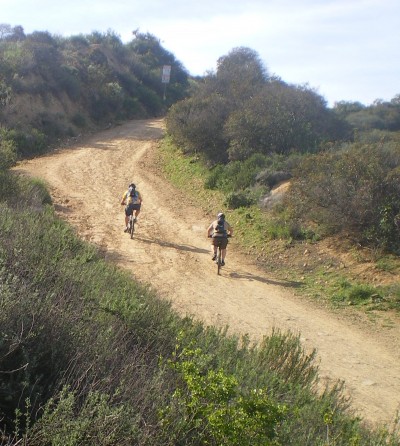
Mountain bikers on Mulholland Drive in Marvin Braude Mulholland Gateway Park in the Santa Monica Mountains National Recreation Area.
Depending on which type of mountain biking you’re interested in, a different set of skills will need to be learned for each. When focused on basic trail riding first, riders are able to learn the basics of the sport that can transition them into more challenging forms and eventually competitions. For the purpose of teaching beginners, this article will focus on the details of trail riding, which is the most popular form of mountain biking.
Taking lessons from an instructor or a friend who is an experienced mountain biker is the best choice for your first time out on a trail. Understanding proper body position and when to shift gears is something that needs to be learned before you even get on a bike. You should keep an upright body position with your elbows bent and the seat at a proper height–have your instructor or experienced friend help adjust it. Spend time practicing shifting gears will assist on the trail when you must be quick to be successful. Shifting to a lower gears makes pedaling easier. The balls of your feet should be planted firmly on your pedals.
Always stay focused on the trail in front of you, as this will allow you to plan your path and alter your body position before reaching the next obstacle. Switch to a standing position with slightly bent knees when coasting over obstacles or rougher terrain, as this will lessen the impact on your body. Practice a standing pedaling position when on flatter grounds where you can shift to higher gears or when in lower gears while going up a hill. A tire is able to brake more intensely the more weight it carries, so your front tire will have a lot of power when going downhill. Make sure to keep this in mind when learning how far in advance to start braking, because if it’s done too late, you risk falling off the bike. When descending a hill, lean back slightly so your weight is placed over the rear tire. If you’re going down a hill at a fast speed and are feeling uncomfortable, lightly pump or feather both your front and back breaks.
Before starting to climb a hill, shift into a lower gear, which will allow more traction and balance when ascending. When going into a turn, brake slightly then accelerate as you’re coming out of the turn to maintain balance. When going over an obstacle, hunch into your bike and gain momentum before there is contact.
Most of the learning process is going to be through trial and error, but having someone with you who knows the sport is essential. Their expertise can provide you with valuable knowledge and the ability to skip ahead to more accelerated mountain biking. Check out a history of mountain biking to find out where the sport originated along with a breakdown of each style of biking.
Essential gear
- Bike
- Helmet
- Glasses
- Shoes
- Biking clothing
- Hydration system
- Tire pump
- GPS
- Bike tool kit
- Food
- Small first aid kit
Image from Cbl62 on the Wikimedia Commons
 Your Privacy Choices
Your Privacy Choices
 The
The